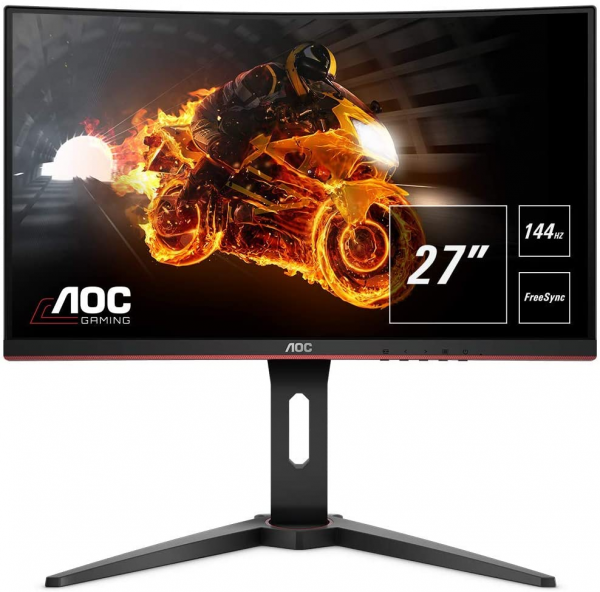AOC
AOC C27G1: a 27 inch Full HD 144 Hz VA monitor well placed
Aprox. 219€
See specificationsThe AOC C27G1 monitor is not part of the manufacturer's Agon range and is therefore placed at a slightly more affordable price. It is nonetheless attractive for players, especially with its FreeSync compatibility, its speed of 144 Hz and its Full HD definition ideal for "small" graphics cards.
Positive points
Good contrast.
Frequency of 144 Hz.
FreeSync compatibility over a wide range.
Cable routing through the hole in the foot.
Bad points
No USB hub.
Viewing angles.
Our review
Presentation
The AOC C27G1 monitor has a 27 inch VA panel displaying a Full HD definition of 1,920 x 1,080 px. The slab is curved over a radius of 1.8 meters (1800R). This model supports a refresh rate of 144 Hz and it is also compatible with FreeSync technology between 48 and 144 Hz. The manufacturer announces a response time of 1 ms, or a reactivity equivalent to that of TN models.
The AOC C27G1 is the direct competitor of the MSI Optix MAG271CR equipped with the same panel, but sold more expensive. Indeed, the AOC C27G1 is displayed at less than 300 € while the MSI Optix MAG271CR is sold for around 450 €.
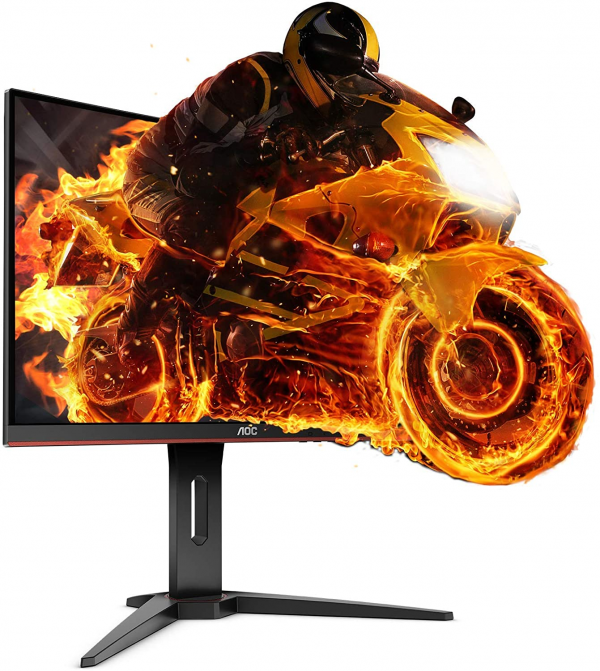
Ergonomics
Unsurprisingly, this monitor is part of the current trend that monitors for players are more and more discreet. The AOC C27G1 is therefore as simple as possible. Black is essential and only a few touches of red give a gaming aspect. The screen edges are quite thin and the finishes are neat. In addition, the 27-inch slab benefits from a matt coating which limits annoying reflections.
At the back, we find the same philosophy, with a little more red. The base has an opening which acts as a fairly basic, but effective cable passage.
It is possible to adjust the height to 13 cm and the tilt between -4 ° and + 21.5 °. The different adjustments are made smoothly without any extraneous noise.
In addition to adjusting the height and tilt, the monitor also allows rotation through ± 34 °, which is always handy for changing angles without moving the stand.
The connection includes two HDMI ports, a DisplayPort 1.2 input, a headphone output and a VGA input. AOC ignores the USB hub which allows you to connect peripherals directly to the screen.
Four buttons located at the base of the panel allow you to access the various settings and change the source. Nothing new on this side at AOC, the navigation is still laborious and the menus are not always clear. The OSD allows adjustment of brightness, contrast, gamma, color temperature, overdrive and offers some game presets including two customizable.
On our 140 x 60 cm desk, the AOC C27G1 occupies a reasonable space. Even if it is not the smallest for a 27 inch model, the 24.5 cm deep foot leaves enough space for the keyboard and mouse. In addition, its airy design frees up space on the desk. The Full HD definition on this 27-inch diagonal makes it possible to exploit the full potential of a mid-range card, such as a GeForce GTX 1060 or 1070 previously set to 144 Hz or a Radeon RX580 in FreeSync. On the other hand, Full HD is henceforth not very suitable for office use, we easily prefer the Quad HD definition (2,560 x 1,440 px) which makes it possible to enlarge the workspace.
This monitor consumes about 17 W with a white set at 150 cd / m². Relative consumption is therefore limited to 85 W / m², a value lower than the average of the screens tested (100 W / m²). At a minimum of brightness (16 cd / m²), the monitor consumes 8 W and rises to a maximum of 26 W (241 cd / m²).
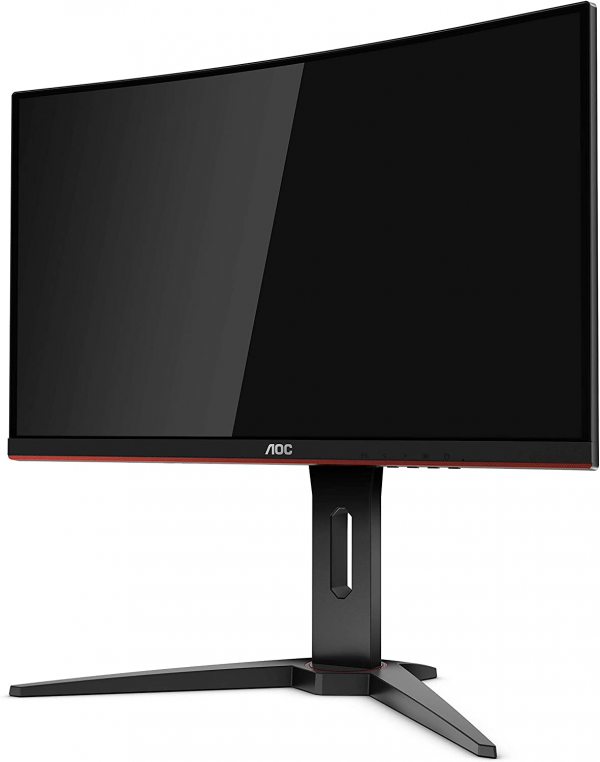
Colors and contrast
As soon as it comes out of the box, this monitor displays an average image. The temperature settles on an average of 7,080 K, not very far from the 6,500 K of reference, but especially the curve ensures a certain stability on the whole of the spectrum. The average gamma measured at 2 is a little far from the reference value (2.2), but the curve is stable. With an average delta E measured at 3.3, the colors cannot be considered as faithful. Indeed, beyond a Delta E of 3, the human eye can perceive the difference between the colors requested and the colors displayed. The drift of red and green is clearly visible with a Delta E greater than 6.
By lowering the brightness to 47 and setting the gamma to 2, we obtain a blank at 150 cd / m² on our test pattern. We did not find any manual settings to improve things. The average temperature drops to 7,040 K, slightly closer to the 6,500 K reference. The gamma curve maintains the same profile and an average of 2, while the colors are a little less precise with delta E measured at 3.7.
Calibrating the monitor to the probe perfectly smoothes the gamma and temperature curves on the target values (6,530 K and 2.2). The colors can finally be considered as faithful with a Delta E less than 3 (2,4). The color profile is available on this link.
Black drops to 0.04 cd / m², which translates into a very good contrast ratio, close to 3,640: 1. The AOC C27G1 approaches the most contrasting monitors in our comparison, such as the AOC Q3279VWF, the Textorm TX32 or the Philips BDM4037UW which exceed a contrast ratio of 4,000: 1.
The average difference in brightness uniformity is measured at only 6% over the entire 27-inch panel; a benchmark that few monitors achieve. The model we tested was not affected by any clouding phenomenon.
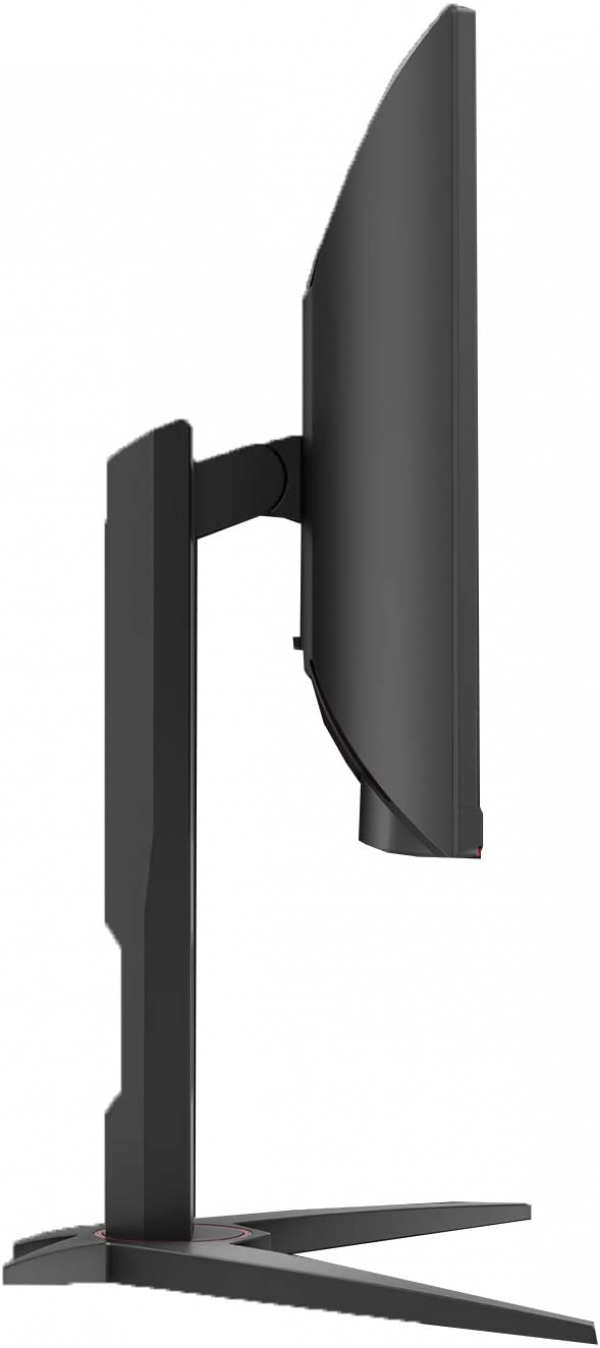
Reactivity
This screen does not use pulse width modulation (PWM or "Pulse Width Modulation") to manage the LEDs of the backlight system, which makes it possible to reduce the brightness without risking a flickering effect causing eye fatigue and headaches for the most sensitive people. This feature is commonly known as Flicker-Free. It also has a blue light reduction mode via software adjustment.
The AOC C27G1 is compatible with FreeSync technology which dynamically shifts the screen refresh rate to the number of images per second produced by the graphics card, in order to avoid the phenomenon of image tearing (tearing) and micro-slowdowns (stuttering). The supported frequency range is quite wide since the FreeSync works here between 48 and 144 Hz.
The reactivity of 7.5 ms is excellent for a VA panel, but not better than that of the MSI Optix MAG271CR (5 ms), the Samsung C32HG70 and the Iiyama G-Master G3266HS. This value is obtained with a setting of the overdrive ("overintensive" in French) to "medium", without showing a reverse ghosting effect.
We measured the display lag (input lag) at 12 ms. There is therefore no discernible lag between the sending of the image by the graphics card and its display on the screen.
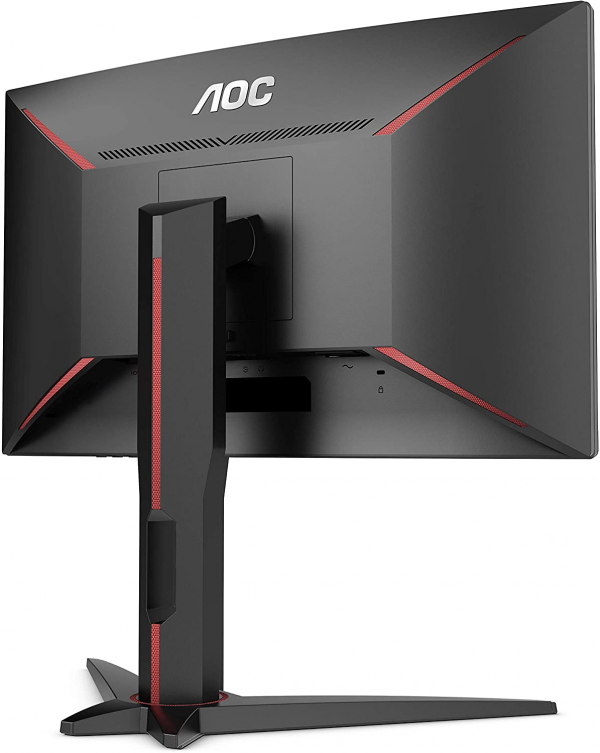
Conclusion
The AOC C27G1 monitor is not perfect, but it offers a good quality / price compromise. The image is not free from defects, but it is far from bad. The contrast is excellent and the reactivity is good without being the best. In short, a monitor in the medium high, but far from exceptional. Something to have fun without breaking the bank in some way.
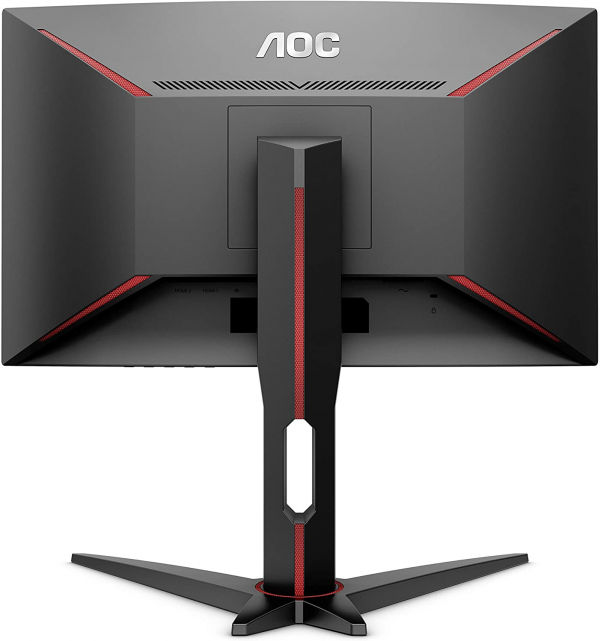
Specifications

